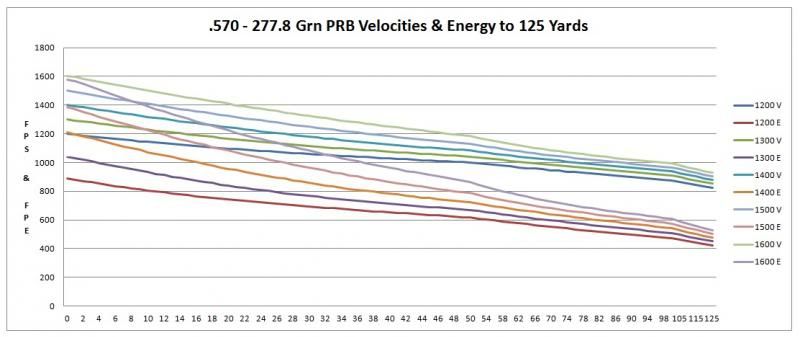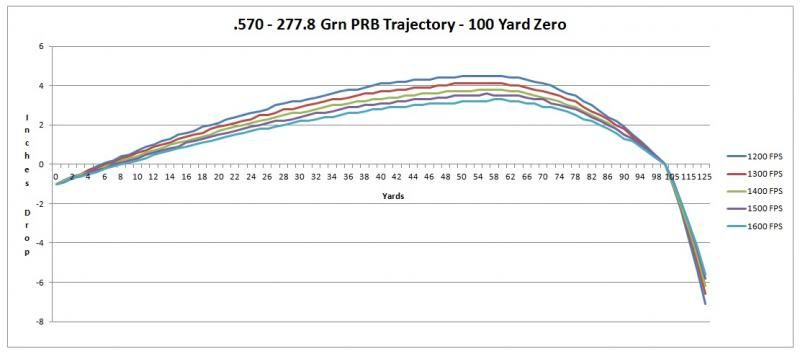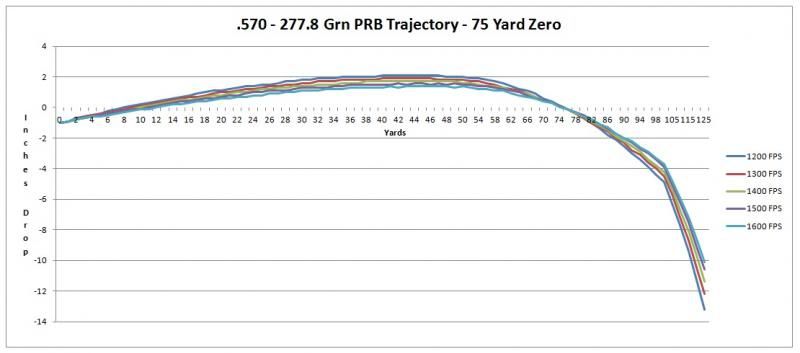localfiend
32 Cal.
- Joined
- Dec 18, 2009
- Messages
- 36
- Reaction score
- 5
To make a long story short, I'm essentially getting a custom .58 rifle barrel for my Thompson Center Hawken. I want to shoot PRB as accurately as possible with powder charges towards the heavy end of the scale.
For the long story, look here:
http://www.muzzleloadingforum.com/fusionbb/showtopic.php?tid/285738/tp/1/
Ok, lets start with a short list of my goals.
1.) Accurate out to 100 yards
2.) Lethal enough to drop an elk at 100 yards
3.) Ease of use - Flatest Trajectory - Point & Click
4.) Manageable Recoil
Number 1 will deal directly with twist rate, which I'm hoping to figure out from input I get here.
Number 2 seems to be a bit ethereal. I've been doing a good bit of reading on PRB lethality, but it seems that not enough science has been applied to the subject to make a good measurement. Since that information doesn't seem to exist, I'm going to take a look at what data Is available and pehaps do some testing when I get my rifle back together.
To start with, I've been playing with the round ball ballistics calculator found here:
http://www.ctmuzzleloaders.com/ctml_experiments/rbballistics/rbballistics.html
Through some internet searching I've come up with a set of velocities that seem to run from the low end, up to the medium-high end of the scale for a .58.
A bit of fiddling in excel and you get a chart that looks like this:
.570 Patched Round Ball
277.8 Grain
Sea Level Altitude
70 Degrees Fahrenheit

My first thoughts when looking at that data were; "Wow, round balls sure slow down fast!", and there must be hardly any felt recoil with those starting velocities.
I'm all for hearing input on what those velocities and energy reading mean, but I am aware that there isn't a lot of correlation currently. What we need are some tests with ballistics gel at varying velocities to see what happens. Then we might be able to make numbers mean something. Right now we've just got 100's of years of experience of PRB's killing things dead. :haha:
I believe I have solved Number 3 with the following two charts:
.570 Patched Round Ball
277.8 Grain
Sight Height from Bore Center 1"
Sea Level Altitude
70 Degrees Fahrenheit


Looks like more power is still better, not as much as it would be in a smokeless gun, but you can still flatten things out better without getting too crazy on the powder.
Also, I'm probably best off having a sighting point somewhere in-between 75 and 100 yards for the greatest consistency across that range.
As for number 4, I would like input from you all on what is reasonable.
From searching around on the board, and other places on the internet it seems that a powder charge of around 120 grains FFg is what it's going to take to achieve velocities above 1500 fps.
I'm pretty new to the world of muzzleloaders so that doesn't mean much to me recoil wise. If I compare that to my biggest smokeless gun. A .375 ruger, with which a standard load pushes a 300grn pill at 2660 FPS. This makes me think that the felt recoil of a heavy .58 is probably less than half as powerfull, perhaps a bit less than a .30-06.
If the recoil is actually around that level, I'm not going to have any problems at all on a shooter level. Flinching ect... will not come into play. The thing I don't know is what will that do the gun. I believe that Thompson Center may have manufactured 1" barrels in .58 cal, but I don't have any max load data. Anyone have any input on max loads?
I want to find the heaviest load that is reasonable, and then match the twist rate for best accuracy for that load.
For the long story, look here:
http://www.muzzleloadingforum.com/fusionbb/showtopic.php?tid/285738/tp/1/
Ok, lets start with a short list of my goals.
1.) Accurate out to 100 yards
2.) Lethal enough to drop an elk at 100 yards
3.) Ease of use - Flatest Trajectory - Point & Click
4.) Manageable Recoil
Number 1 will deal directly with twist rate, which I'm hoping to figure out from input I get here.
Number 2 seems to be a bit ethereal. I've been doing a good bit of reading on PRB lethality, but it seems that not enough science has been applied to the subject to make a good measurement. Since that information doesn't seem to exist, I'm going to take a look at what data Is available and pehaps do some testing when I get my rifle back together.
To start with, I've been playing with the round ball ballistics calculator found here:
http://www.ctmuzzleloaders.com/ctml_experiments/rbballistics/rbballistics.html
Through some internet searching I've come up with a set of velocities that seem to run from the low end, up to the medium-high end of the scale for a .58.
A bit of fiddling in excel and you get a chart that looks like this:
.570 Patched Round Ball
277.8 Grain
Sea Level Altitude
70 Degrees Fahrenheit

My first thoughts when looking at that data were; "Wow, round balls sure slow down fast!", and there must be hardly any felt recoil with those starting velocities.
I'm all for hearing input on what those velocities and energy reading mean, but I am aware that there isn't a lot of correlation currently. What we need are some tests with ballistics gel at varying velocities to see what happens. Then we might be able to make numbers mean something. Right now we've just got 100's of years of experience of PRB's killing things dead. :haha:
I believe I have solved Number 3 with the following two charts:
.570 Patched Round Ball
277.8 Grain
Sight Height from Bore Center 1"
Sea Level Altitude
70 Degrees Fahrenheit


Looks like more power is still better, not as much as it would be in a smokeless gun, but you can still flatten things out better without getting too crazy on the powder.
Also, I'm probably best off having a sighting point somewhere in-between 75 and 100 yards for the greatest consistency across that range.
As for number 4, I would like input from you all on what is reasonable.
From searching around on the board, and other places on the internet it seems that a powder charge of around 120 grains FFg is what it's going to take to achieve velocities above 1500 fps.
I'm pretty new to the world of muzzleloaders so that doesn't mean much to me recoil wise. If I compare that to my biggest smokeless gun. A .375 ruger, with which a standard load pushes a 300grn pill at 2660 FPS. This makes me think that the felt recoil of a heavy .58 is probably less than half as powerfull, perhaps a bit less than a .30-06.
If the recoil is actually around that level, I'm not going to have any problems at all on a shooter level. Flinching ect... will not come into play. The thing I don't know is what will that do the gun. I believe that Thompson Center may have manufactured 1" barrels in .58 cal, but I don't have any max load data. Anyone have any input on max loads?
I want to find the heaviest load that is reasonable, and then match the twist rate for best accuracy for that load.
Last edited by a moderator:








